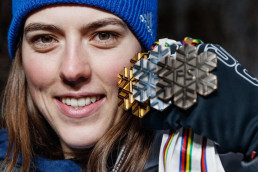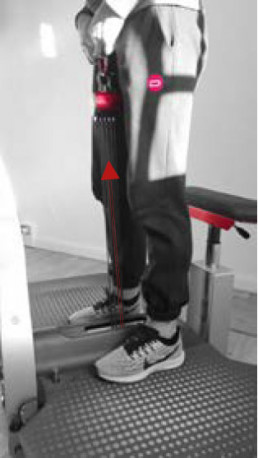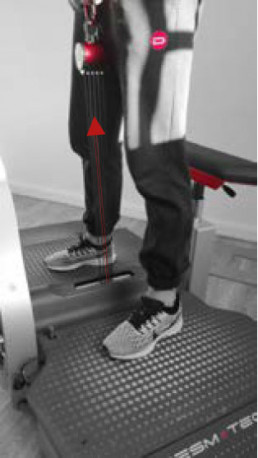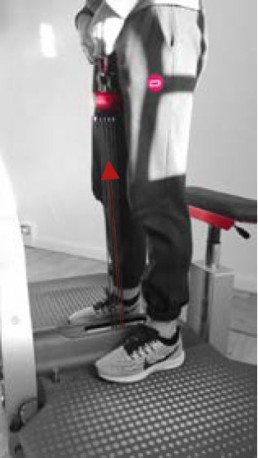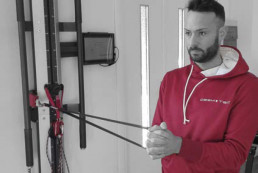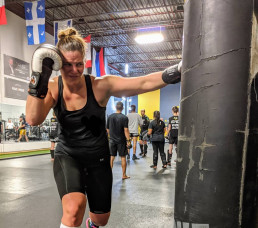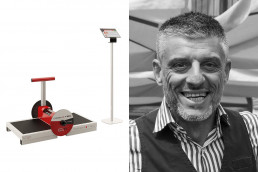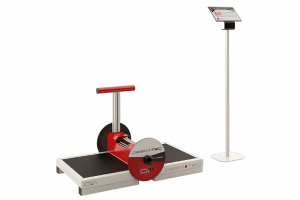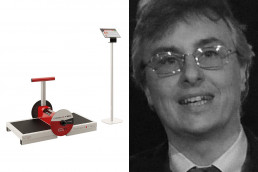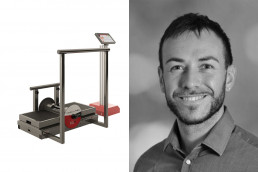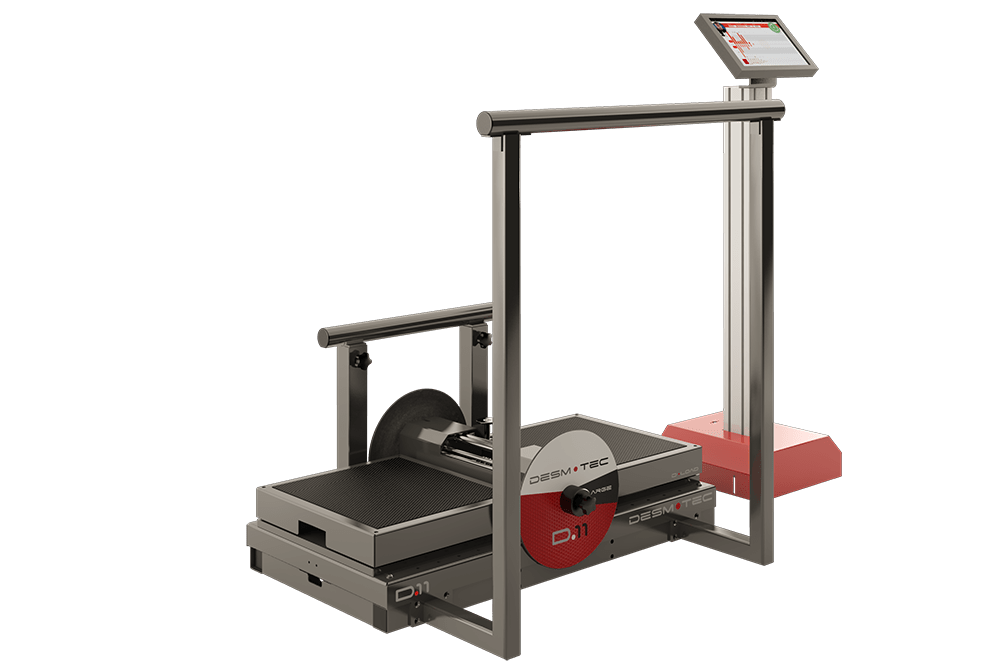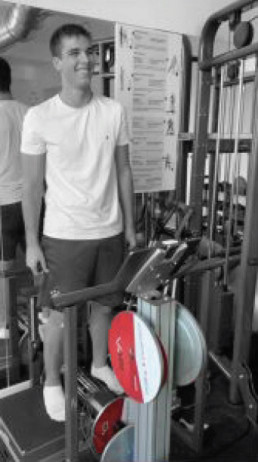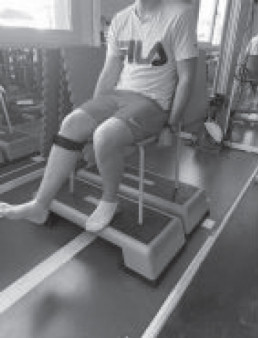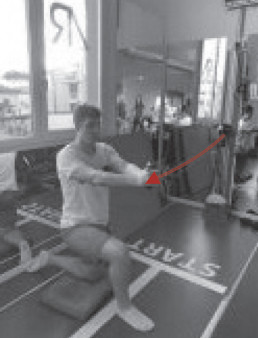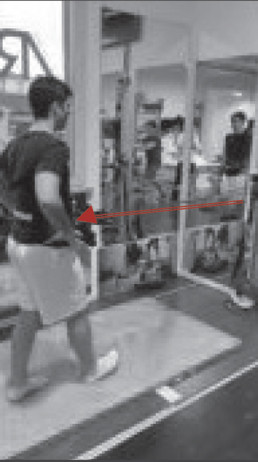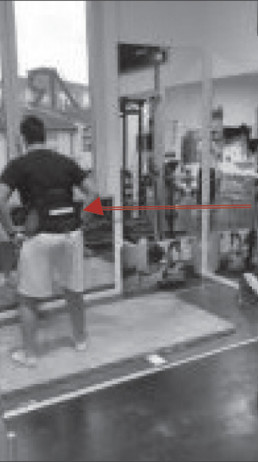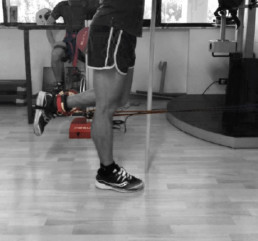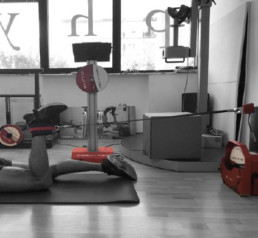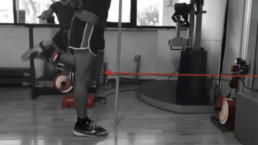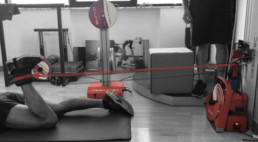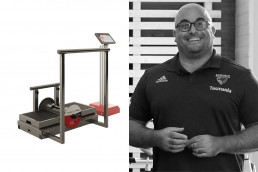Arm Pushing for core activation using Desmotec V.Sport - Petra Vlhova
ATHLETE
Petra Vlhová is a professional Slovak World Cup alpine ski racer who is specialised in the technical events of slalom and giant slalom. She is the current world champion in giant slalom.
EXERCISE
In the video below, She is performing an exercise where she has to push with one arm, preventing the rotation of the trunk, through an activation of the core. She also performs small extension of her legs to maximise her power during this movement.
During the repetitions, she holds the handle in her hands in order to involve the core and maximise power tranfert.
TRAINING WITH DESMOTEC DEVICES
This exercise is only a small piece of Petra’s personalized training programme. The final goal of this exercise is to maximise her performances in skiing.
The choice of using Desmotec V.Sport is mainly based on th compact design of the machine which allow the athletes and the trainer to transport it where they need it, providing the opportunity to train anywhere. In addition, the device is ideal for this kind of training, as it allow the athlete to develop high power and high velocity in a safe manner.
Would you like to know more about DESMOTEC technology, devices and training methods?
Athletic Pubalgia
PROBLEM
As regards the treatment of a problem of athletic pubalgia, this case was approached through a specific DTS treatment, formed by two main sessions.
TREATMENT
The patient, during the first session, started with a light warm-up in order to activate the dorsal/lumbar area, followed by two balance tests and one isometric test, using Desmotec devices. The result of the tests showed a slight imbalance towards the left side (about 20%). The patient then performed three sets of squats (with variants), using D and two sets of rotation exercises using the V, finishing the first session with three sets of sumo squats on D, equipped with disk type “PRO”. During the second session the patient repeated the same exercises using D and V, obtaining immediate results. The average balance changed from 20% to about 0%, while the pain gradually disappeared.
RESULTS
The Desmotec devices contributed to the identification of the patient’s slight imbalance towards the left side, therefore it was then possible to intervene and solve it along with the problem linked to pubalgia.
Would you like to know more about DESMOTEC technology, devices and training methods?
Lateral Step using Desmotec V.Full - Marie-Eve DiCaire
ATHLETE
Marie-Eve DiCaire is a Canadian professional boxer and she has held the IBF female light middleweight title since 2018. In 2013, she was named athlete of the year by Boxing Quebec. As of November 2019, she is ranked as the world’s best active female light middleweight by BoxRec.
EXERCISE
In the video below, she is performing a Lateral Step exercise using Desmotec V.Full. The main aim of this exercise is to improve speed, quickness and precision relative to the footwork, focusing on side and lateral movements.
During the repetitions, she holds the handle in her hands in order to involve the core and maximise power tranfert.
TRAINING WITH DESMOTEC DEVICES
Desmotec devices allow athletes and trainers to take advantage of the highspeed eccentric/concentric turnover. This specific characteristic is so important for athletes whose main focus is improving power.
In addition, Desmotec V.Full allow her to work and perform exercises focusing on very specific angles of motion and on the technical gesture.
Would you like to know more about DESMOTEC technology, devices and training methods?
Front Squat on D.Sport - Oscar Rivas
ATHLETE
Oscar Rivas is a Colombian professional boxer who fought once for the vacant WBC interim heavyweight title in 2019. He has previously held the IBF International, WBC-NABF and WBO-NABO heavyweight titles. As an amateur he won a silver medal at the 2007 Pan American Games.
EXERCISE
In the video below, he is performing a Front Squat exercise on Desmotec D.Sport. Thanks to this particular workout, he can focus on eccentric training in order to develop and improve reactive power in the lower limbs.
In this case , he is performing 4 shorts movements to create a peak of velocity and then eccentricly absorb it while performing a full squat. The entire cicle has to be repeated four time.
TRAINING WITH DESMOTEC DEVICES
As the athlete needs to develop peaks of eccentric power and perform this movement for multiple repetitions, Desmotec machines are ideal for this purpose. The eccentric training along with the support provided by the Software D.Soft, allow the user and the trainer to track power peaks in real time, obtaining a complete report about progresses and performances at the end of the exercise. This is a fundamental part in developing a personalized training programme for the athletes in order to gradually improve their performances.
Would you like to know more about DESMOTEC technology, devices and training methods?
Eccentric Power and Return to Sport after ACL Reconstruction
Scientific study for Physiotherapists
It was presented at the “XXII International Congress of Sport Rehabilitation and Traumatology”, in Milan Italy.
The study was published by Sebastiano Zuppardo, Physiotherapist, knee specialist and Desmotec Academy member.
The aim of this project was to assess the eccentric strenght deficit during the last rehabilitation phase after ACL reconstruction and the recovery of such deficit after resuming agonistic sport activity. The device DESMOTEC D.SPORT was used during the research process.
Desmotec D.SPORT
ABSTRACT
This study tries to assess the eccentric strength deficit during the last rehabilitation phase after ACL recnstruction and the recovery of such deficit after resuming agonistic sport activity. As a matter of fact, many studies have lately focused their attention on the recovery of the eccentric strength by means of rehabilitation protocols with earlt high intensity resistance exercises stimulating the eccentric phase.
Click here to read the whole feature.
DESMOTIPS SCIENTIFIC EVIDENCE:
- G. Annibalini, Muscle and Systemic Molecular Responses to a Single Flywheel Based Iso-Inertial Training Session in Resistance-Trained Men, Università Carlo Bo di Urbino
- M. Beato, EPost-activation potentiation effect of eccentric overload and traditional weightlifting exercise on jumping and sprinting performance in male athletes, University of Suffolk
- M.Beato, Effects of postactivation potentiation after an eccentric overload bout on countermovement jump and lower-limb muscle strength, University of Suffolk.
- G. Coratella, Effects of in-season enhanced negative work-based vs traditional weight training on change of direction and hamstrings-to-quadriceps ratio in soccer players, Università degli Studi di Milano.
- D.Susta, Isoinertial exercise does not cause clinically significant muscle damage: A pilot study, Dublin City University
Isoinertial exercise does not cause clinically significant muscle damage: A pilot study
Scientific Feature about Isoinertial exercise and health.
Published by Dr. Davide Susta and a team of researchers of the Dublin City University on the Journal Cultura, Ciencia y Deporte, January 2014
The aim of the present study is to measure changes in exercise-induced muscle damage and soreness as result of one isoinertial concentric-eccentric maximal exercise session. DESMOTEC DEVICES were used during this research project.
Desmotec D.SPORT
ABSTRACT
Eccentric exercise has often been associated with skeletal muscles structural damage and athletes may experience signs and symptoms such as limited range of motio and muscle soreness of the muscles across the joint. The isoinertial modality provides additional eccentric load. To our knowledge, no previous study has investigated thE effect of isoinertial exercise, which consists of both concentric and eccentric muscular actions, on exercise-induced muscle damage. Aim of the present study is to measure
changes in exercise-induced muscle damage and soreness as result of one isoinertial concentric-eccentric maximal exercise session.
Click here to read the whole feature.
DESMOTIPS SCIENTIFIC EVIDENCE:
- G. Annibalini, Muscle and Systemic Molecular Responses to a Single Flywheel Based Iso-Inertial Training Session in Resistance-Trained Men, Università Carlo Bo di Urbino
- M. Beato, EPost-activation potentiation effect of eccentric overload and traditional weightlifting exercise on jumping and sprinting performance in male athletes, University of Suffolk
- M.Beato, Effects of postactivation potentiation after an eccentric overload bout on countermovement jump and lower-limb muscle strength, University of Suffolk.
- G. Coratella, Effects of in-season enhanced negative work-based vs traditional weight training on change of direction and hamstrings-to-quadriceps ratio in soccer players, Università degli Studi di Milano.
- S. Zuppardo, Eccentric Power and Return to Sport after ACL Reconstruction, XXII International Congress of Sport Rehabilitation and Traumatology
Post-activation potentiation effect of eccentric overload and traditional weightlifting exercise on jumping and sprinting performance in male athletes
Scientific feature that evaluate the PAP effects on pre-determined exercises, following eccentric overload.
It was published by Prof. Marco Beato, Desmotec Academy Member and Senior Lecturer in Strength & Conditioning at University of Suffolk, on the Journal PLoS ONE, Semptember 2019.
The aim of this study was to evaluate the post-activation potentiation (PAP) effects following eccentric overload (EOL) and traditional weightlifting (TW) exercise on standing long jump (SLJ), countermovement jump (CMJ), and 5 m sprint acceleration performance. DESMOTEC DEVICE D.FULL was used during the research process.
Desmotec D.FULL
ABSTRACT
The aim of this study was to evaluate the post-activation potentiation (PAP) effects following eccentric overload (EOL) and traditional weightlifting (TW) exercise on standing long jump (SLJ), countermovement jump (CMJ), and 5 m sprint acceleration performance. Ten male athletes were involved in a randomized, crossover study. The subjects performed 3 sets of 6 repetitions of EOL or TW half squat exercise followed by SLJ, CMJ, and 5 m sprint tests at 1 min, 3 min and 7 min, in separate sessions using a randomized order. Bayes factor (BF10) was reported to show the strength of the evidence. Differences were found using EOL for SLJ distance at 3 min (BF10 = 7.24, +8%), and 7 min (BF10 = 19.5, +7%), for CMJ at 3 min (BF10 = 3.25, +9%), and 7 min (BF10 = 4.12, +10.5%). Differences were found using TW exercise for SLJ at 3 min (BF10 = 3.88, +9%), and 7 min (BF10 = 12.4, +9%), CMJ at 3 min (BF10 = 7.42, +9.5%), and 7 min (BF10 = 12.4, +12%). No meaningful differences were found between EOL and TW exercises for SLJ (BF10 = 0.33), CMJ (BF10 = 0.27), and 5 m sprint (BF10 = 0.22). In conclusion, EOL and TW exercises acutely increase SLJ and CMJ, but not 5 m sprint performance. The PAP time window was found between 3 min and 7 min using both protocols. This study did not find differences between EOL and TW exercises, and so both methodologies can be used to stimulate a PAP response.
Click here to read the whole feature.
DESMOTIPS SCIENTIFIC EVIDENCE:
- G. Annibalini, Muscle and Systemic Molecular Responses to a Single Flywheel Based Iso-Inertial Training Session in Resistance-Trained Men, Università Carlo Bo di Urbino
- M.Beato, Effects of postactivation potentiation after an eccentric overload bout on countermovement jump and lower-limb muscle strength, University of Suffolk.
- G. Coratella, Effects of in-season enhanced negative work-based vs traditional weight training on change of direction and hamstrings-to-quadriceps ratio in soccer players, Università degli Studi di Milano.
- D.Susta, Isoinertial exercise does not cause clinically significant muscle damage: A pilot study, Dublin City University
- S. Zuppardo, Eccentric Power and Return to Sport after ACL Reconstruction, XXII International Congress of Sport Rehabilitation and Traumatology
ACL Rehabilitation
PROBLEM
In the case of a patient facing an ACL rehabilitation; the whole rehab program was based on a specific path focusing on muscular reinforcement, using mainly the Desmotec D and V.
TREATMENT
During the first phases, Desmotec devices played a very important role in monitoring the patient’s progresses on shifting the load from healthy to operated limb, using D for balance and isometric tests, followed by exercises with specific strap on the V. The last phase of the rehab process was focused on achieving the complete leg extension, complete balance recovery and full load on the limb, using the V for functional movement equipped with a specific tool and isometric works.
RESULTS
Desmotec devices allowed the patient to overcome the temporal gap linked to re-conditioning, in full compliance with the physiological time previously estimated. Desmotec therefore allowed to re-evaluate the whole rehab preparatory linked to the functionality of the final gesture.
Would you like to know more about DESMOTEC technology, devices and training methods?
Hamstrings Tendinopathy
PROBLEM
In the specific case of a patient (runner) affected by insertional left hamstring pain with tendinopathy, the Desmotec devices allowed the introduction of analytical and global exercises since the first stages of the rehab process.
TREATMENT
In the first months, the main goal was to remove any form of pain at rest and during the deambulation phase. Then, some specific exercises focused on contraction along with the isometric phase were introduced, using D and V devices. The patient started a cycle of three training sessions per week, using Desmotec devices and alternating these sessions with running trainings. After the first two weeks, the patient then started a macro-cycle of 24 sessions focused on strength-work, one and two legs squats, using the D device, in order to improve the patient’s strength in the lower limbs, along with mono-articular exercises of pull from prone and standing position, aimed at improving selective strength, using V device.
RESULTS
Desmotec machines allowed the continuation of the different phases regarding the rehab protocol previously studied, also giving the possibility to compare the patient’s improvements in increasing his strength and power.
Would you like to know more about DESMOTEC technology, devices and training methods?
Effects of in-season enhanced negative work-based vs traditional weight training on change of direction and hamstrings-to-quadriceps ratio in soccer players
Scientific features that investigates the effects of in-season enhanced negative work-based training (ENT) vs weight training in semi-professional soccer players, evaluated and measured through specific tests.
It was published by Dr. Giuseppe Coratella, researcher at the Università degli Studi in Milan, along with Prof. Marco Beato, Desmotec Academy member and Senior Lecturer in Strength & Conditioning at University of Suffolk, on Biol Sport, September 2019.
The study focuses on the different effects of in-season enhanced negative work-based training (ENT) and weight training in the change of direction (COD), sprinting and jumping ability, muscle mass and strength in semi-professional soccer players. The Desmotec device D.Full was also used in the research process.
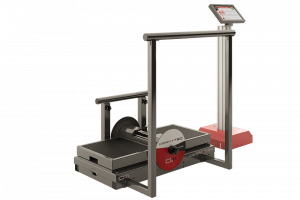
Desmotec D.FULL
ABSTRACT
The present study investigated the effects of in-season enhanced negative work-based training (ENT) vs weight training in the change of direction (COD), sprinting and jumping ability, muscle mass and strength in semi-professional soccer players.
Forty male soccer players participated in the eight-week, 1 d/w intervention consisting of 48 squat repetitions for ENT using a flywheel device (inertia=0.11 kg·m-2) or weight training (80%1 RM) as a control group (CON). Agility T-test, 20+20 m shuttle, 10 m and 30 m sprint, squat jump (SJ) and countermovement jump (CMJ), lean mass, quadriceps and hamstrings strength and the hamstrings-to-quadriceps ratio were measured. Time on agility T-test and 20+20 m shuttle decreased in ENT (effect-size =-1.44, 95% CI -2.24/-0.68 and -0.75, -1.09/-0.42 respectively) but not in CON (-0.33, -0.87/0.19 and -0.13, -0.58/0.32). SJ and CMJ height increased in both ENT (0.71, 0.45/0.97 and 0.65, 0.38/0.93) and CON (0.41, 0.23/0.60 and 0.36, 0.12/0.70). Overall, quadriceps and hamstrings strength increased in both ENT and CON (0.38/0.79), but the hamstrings-to-quadriceps ratio increased in ENT (0.31, 0.22/0.40) but not in CON (0.03, -0.18/0.24). Lean mass increased in both ENT (0.41, 0.26/0.57) and CON (0.29, 0.14/0.44). The repeated negative actions performed in ENT may have led to improvements in braking ability, a key point in COD performance. Semi-professional soccer players may benefit from in-season ENT to enhance COD and the negative-specific adaptations in muscle strength and hamstrings-to-quadriceps ratio.
Click here to access the whole feature.
DESMOTIPS SCIENTIFIC EVIDENCE:
- G. Annibalini, Muscle and Systemic Molecular Responses to a Single Flywheel Based Iso-Inertial Training Session in Resistance-Trained Men, Università Carlo Bo di Urbino
- M. Beato, EPost-activation potentiation effect of eccentric overload and traditional weightlifting exercise on jumping and sprinting performance in male athletes, University of Suffolk
- M.Beato, Effects of postactivation potentiation after an eccentric overload bout on countermovement jump and lower-limb muscle strength, University of Suffolk.
- D.Susta, Isoinertial exercise does not cause clinically significant muscle damage: A pilot study, Dublin City University
- S. Zuppardo, Eccentric Power and Return to Sport after ACL Reconstruction, XXII International Congress of Sport Rehabilitation and Traumatology
